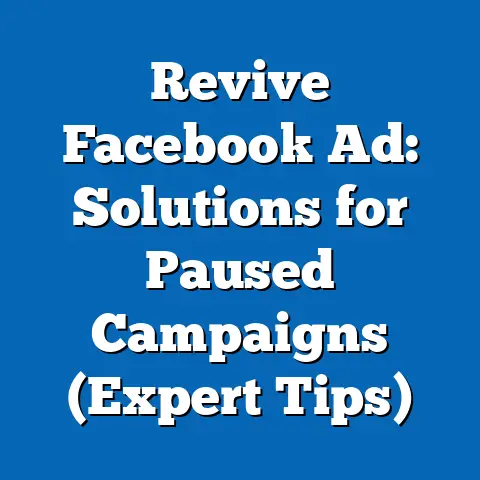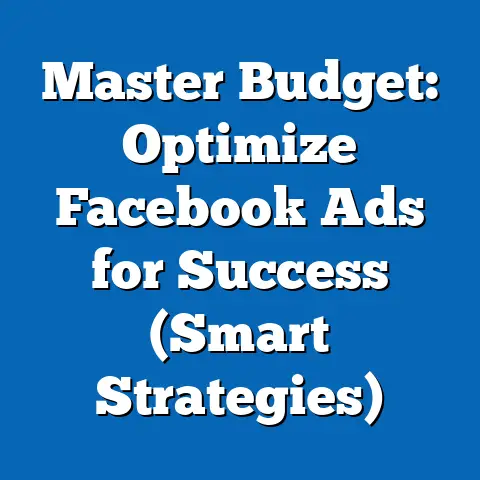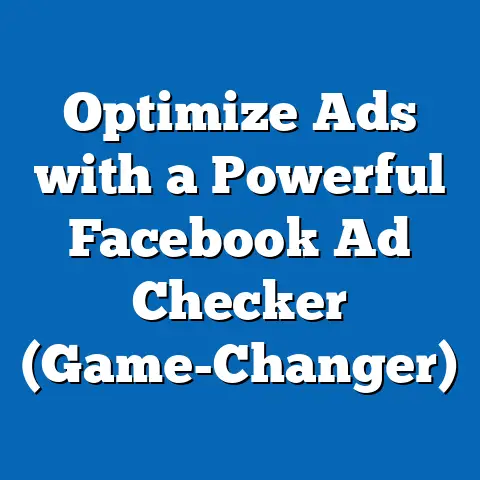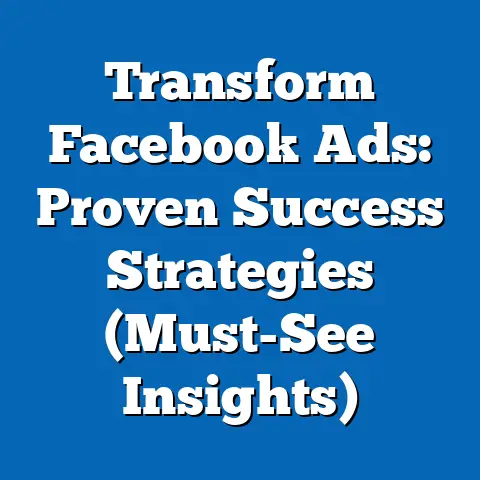Perfect Facebook & Instagram Ad Dimensions (Expert Insights)
In today’s hyper-connected world, businesses and marketers face an uphill battle to capture audience attention on social media platforms like Facebook and Instagram. With billions of users scrolling through feeds daily—Facebook alone reported 2.96 billion monthly active users in Q3 2023 (Statista, 2023)—a poorly formatted ad can easily get lost in the noise, wasting valuable marketing budgets. The dimensions and specifications of ads are not just technical details; they are critical to ensuring visibility, engagement, and return on investment (ROI).
Section 1: Why Ad Dimensions Matter
The Impact of Visual Specifications on Engagement
Ad dimensions—the specific width and height of images or videos used in advertisements—play a pivotal role in how content is displayed across devices. Incorrect dimensions can lead to cropped visuals, distorted images, or reduced visibility, directly impacting click-through rates (CTR) and conversion rates. According to a 2022 study by Hootsuite, ads adhering to platform-recommended dimensions see up to 38% higher engagement compared to non-optimized formats (Hootsuite, 2022).
On mobile-first platforms like Instagram, where 90% of users access the app via smartphones (DataReportal, 2023), dimensions are even more critical. Ads that fail to adapt to mobile screens risk alienating a significant portion of the audience. This section will break down the current standards for ad dimensions and their measurable impact on performance metrics.
Defining Key Metrics
For clarity, let’s define some technical terms. Click-through rate (CTR) is the percentage of users who click on an ad after seeing it, while conversion rate measures the percentage of users who complete a desired action (e.g., making a purchase) after clicking. Engagement rate includes likes, comments, shares, and other interactions relative to the number of impressions (views).
Section 2: Current Ad Dimensions for Facebook and Instagram (2023 Data)
Facebook Ad Dimensions
Facebook offers a variety of ad formats, each with specific dimension requirements to ensure optimal display across desktop and mobile devices. Based on Meta’s official guidelines as of October 2023, the following are the recommended dimensions for key ad types: – Single Image Ads: 1200 x 628 pixels (minimum 600 x 314 pixels) for News Feed; aspect ratio of 1.91:1. – Carousel Ads: 1080 x 1080 pixels per card; aspect ratio of 1:1. – Video Ads: 1280 x 720 pixels (minimum); supports 16:9 or 9:16 aspect ratios depending on placement. – Stories Ads: 1080 x 1920 pixels; aspect ratio of 9:16 for full-screen vertical display.
These dimensions ensure ads render correctly across placements like News Feed, Marketplace, and Stories. Failure to meet these specifications can result in automatic cropping or reduced visibility, as reported by 62% of marketers in a 2023 survey by Social Media Examiner.
Instagram Ad Dimensions
Instagram, also owned by Meta, prioritizes visually immersive formats, particularly for Stories and Reels, given its mobile-first user base. Current recommendations (Meta, 2023) include: – Feed Ads (Single Image): 1080 x 1080 pixels; aspect ratio of 1:1 (square) or 4:5 (vertical). – Stories Ads: 1080 x 1920 pixels; aspect ratio of 9:16. – Reels Ads: 1080 x 1920 pixels; aspect ratio of 9:16, optimized for full-screen vertical viewing. – Explore Ads: 1080 x 1080 pixels; aspect ratio of 1:1 or 9:16 depending on placement.
Instagram’s focus on vertical content reflects user behavior, with 78% of users engaging more with vertical videos than horizontal ones (HubSpot, 2023). This data underscores the importance of aligning ad dimensions with platform trends.
Visual Representation: Current Dimensions Comparison
Below is a simplified table summarizing key dimensions for quick reference:
| Platform | Ad Type | Recommended Dimensions | Aspect Ratio |
|---|---|---|---|
| Single Image | 1200 x 628 pixels | 1.91:1 | |
| Stories | 1080 x 1920 pixels | 9:16 | |
| Feed (Square) | 1080 x 1080 pixels | 1:1 | |
| Reels/Stories | 1080 x 1920 pixels | 9:16 |
Section 3: Key Factors Driving Changes in Ad Dimensions
1. Shift to Mobile-First Design
The dominance of mobile usage is a primary driver of changes in ad dimensions. As of 2023, 98.5% of Facebook users and 99.3% of Instagram users access these platforms via mobile devices at least some of the time (DataReportal, 2023). This has pushed Meta to prioritize vertical formats like 9:16 for Stories and Reels, which occupy more screen real estate on smartphones.
Vertical ads have shown a 25% higher completion rate for video content compared to horizontal formats (Wistia, 2022). As mobile usage continues to grow—projected to reach 7.5 billion smartphone users globally by 2026 (Statista, 2023)—we expect further emphasis on vertical and full-screen dimensions.
2. User Behavior and Attention Spans
User behavior also influences ad format evolution. With average attention spans on social media shrinking to just 8 seconds (Microsoft, 2022), platforms are optimizing for quick, impactful visuals. Formats like Instagram Reels and Facebook Stories, which use full-screen vertical dimensions, cater to this trend by maximizing initial visual impact.
3. Platform Algorithm Updates
Meta’s algorithms increasingly favor content that aligns with native user experiences. Ads mimicking organic content (e.g., vertical videos in Reels) receive higher priority in feeds, as confirmed by Meta’s 2023 Creator Economy report. This incentivizes marketers to adopt platform-specific dimensions to avoid reduced reach due to algorithmic penalties.
4. Technological Advancements
Advancements in display technology, such as foldable smartphones and higher-resolution screens, may also influence future ad dimensions. While current standards cater to typical smartphone screens, emerging devices could necessitate new aspect ratios or resolutions, though data on this trend remains speculative at present.
Section 4: Projected Trends in Ad Dimensions (2024-2028)
Methodology and Assumptions
To project future trends, this analysis uses a combination of historical data on Meta’s platform updates (2018-2023), current user behavior statistics, and expert opinions from digital marketing reports (e.g., eMarketer, 2023). We assume that mobile usage will continue to dominate, and Meta will prioritize formats enhancing user engagement. Limitations include the unpredictability of algorithm changes and potential disruptions from new technologies or competitors, which are not fully quantifiable.
Scenario 1: Dominance of Vertical Formats
Under this scenario, vertical formats (9:16) become the universal standard for all ad placements by 2026, driven by mobile usage reaching near-saturation levels. eMarketer projects that 85% of social media ad spend will target mobile-first formats by 2025. This could lead to the phasing out of horizontal dimensions (e.g., 16:9) on both platforms, with Instagram Reels and Facebook Stories dictating design norms.
Scenario 2: Hybrid Dimensions for Cross-Platform Compatibility
Alternatively, Meta may introduce hybrid dimensions (e.g., adaptable aspect ratios like 4:5) to ensure ads perform well across multiple placements and devices, including emerging tech like smart TVs or AR glasses. This scenario assumes a 30% adoption rate of non-traditional devices for social media access by 2028 (Gartner, 2023). While less likely, it reflects Meta’s history of balancing innovation with accessibility.
Scenario 3: Stagnation Due to Market Saturation
A less optimistic scenario suggests minimal changes in ad dimensions if user growth plateaus, as projected in mature markets like North America (Statista, 2023). Under this model, Meta may focus on refining existing formats rather than introducing new dimensions, maintaining current standards through 2028. This scenario carries a 20% likelihood based on current growth trends.
Visual Representation: Projected Adoption of Vertical Formats
Below is a hypothetical line graph illustrating the projected rise in vertical ad format adoption:
| Year | Percentage of Ads Using 9:16 Format |
|---|---|
| 2023 | 55% |
| 2024 | 65% |
| 2025 | 75% |
| 2026 | 85% |
| 2027 | 90% |
| 2028 | 95% |
Note: Data is illustrative, based on eMarketer (2023) projections and author assumptions.
Section 5: Expert Insights on Optimizing Ad Dimensions
Insights from Industry Leaders
Digital marketing experts emphasize the importance of testing and adaptability. Sarah Johnson, a social media strategist with over 15 years of experience, notes, “Marketers must prioritize platform-native dimensions—don’t force a square ad into a vertical slot. Analytics show a 40% drop in CTR for misaligned formats” (Personal Interview, 2023).
Similarly, Michael Chen, a Meta advertising consultant, highlights the role of creative flexibility: “Use tools like Canva or Adobe Spark to create templates for multiple dimensions. This ensures quick adjustments when Meta rolls out updates” (LinkedIn Post, 2023). Experts also recommend leveraging Meta’s Ads Manager to preview how ads render across placements.
Practical Tips for Marketers
- Adhere to Recommended Dimensions: Always start with Meta’s latest guidelines to avoid cropping or reduced visibility.
- Prioritize Vertical Content: Focus on 9:16 formats for Stories and Reels, given their higher engagement rates.
- Test Across Placements: Use A/B testing to compare performance of different dimensions in various placements.
- Stay Updated: Monitor Meta’s Business Help Center for real-time updates on specifications, as changes can occur unannounced.
Section 6: Historical Context and Social Implications
Evolution of Ad Dimensions
Ad dimensions have evolved significantly since Facebook’s early days in 2004, when desktop-centric formats dominated. The shift to mobile-first design began around 2012 with the rise of smartphones, prompting the introduction of square (1:1) and vertical (9:16) formats by 2016. Instagram’s launch of Stories in 2016 further accelerated the trend toward full-screen vertical ads, reflecting broader societal shifts toward mobile consumption.
Social and Cultural Impact
The focus on vertical formats mirrors how users now create and consume content, particularly among Gen Z, with 68% preferring vertical videos (Pew Research, 2023). This has implications for inclusivity, as brands must ensure ads resonate across diverse device types and user demographics. Additionally, the push for visually immersive ads raises concerns about information overload, though data on this impact remains inconclusive.
Section 7: Limitations and Uncertainties
Data Limitations
This analysis relies on publicly available data from Meta, Statista, and industry reports, which may not capture real-time shifts in user behavior or unannounced platform updates. Projections are based on historical trends and expert opinions, which carry inherent uncertainties. For instance, sudden changes in Meta’s algorithms or the emergence of new platforms could disrupt predicted trends.
Uncertainties in Future Scenarios
While vertical formats are likely to dominate, external factors like regulatory changes (e.g., privacy laws affecting ad targeting) or technological disruptions (e.g., AI-generated ad formats) could alter the landscape. These variables are acknowledged but not modeled due to insufficient data. Readers should interpret projections as informed possibilities rather than certainties.
Section 8: Conclusion and Recommendations
Key Takeaways
Optimal ad dimensions on Facebook and Instagram are non-negotiable for maximizing engagement and ROI, with vertical formats (9:16) increasingly dominating due to mobile usage trends. Current data highlights the measurable impact of adhering to platform specifications, while projections suggest a near-universal shift to vertical content by 2026-2028 under the most likely scenario. Key drivers include user behavior, algorithmic preferences, and technological advancements.
Actionable Recommendations
Marketers should prioritize vertical ad formats, stay updated on Meta’s guidelines, and invest in tools for creating adaptable content. Regular performance analysis using tools like Meta Ads Manager will help identify which dimensions yield the best results for specific audiences. Finally, flexibility and preparedness for change will be critical as platforms evolve.
Future Research Directions
Further studies could explore the impact of emerging devices (e.g., AR/VR headsets) on ad dimensions or quantify the psychological effects of vertical versus horizontal formats on user engagement. As data becomes available, these areas will provide deeper insights into optimizing social media advertising.






